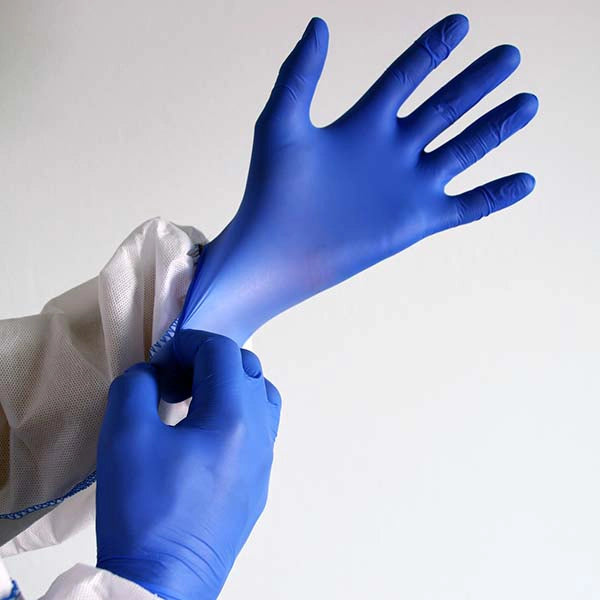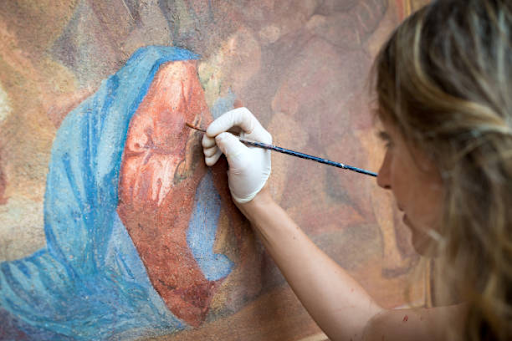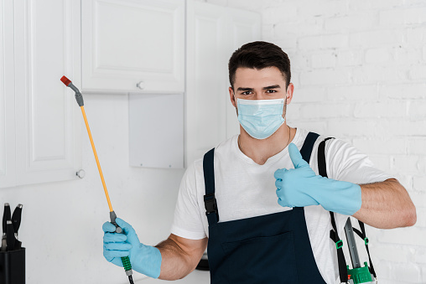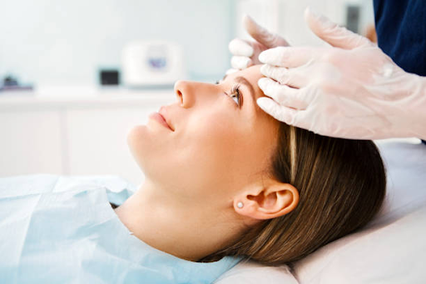Painters require good hand protection gear from various paints and paint preparation chemicals. Primers, thinners, and basecoats, among many others, have chemicals that can pass through the skin and gain entry into the body. Therefore, you have to wear protective gear like gloves when mixing paint, spraying, and gun cleaning to protect yourself from these chemicals.
Not all disposable gloves offer the same level of protection. For instance, latex gloves offer little or no protection against penetration of most solvents. However, they minimize the contact with paint and reduce the clean-up time.
Additionally, most disposable gloves can degrade when exposed to various chemicals found in paints. Therefore, latex is not the best option for painting work. Vinyl gloves do not offer a snug fit, but they are relatively more resistant to turpentine and other petroleum-based solvents than latex gloves. Vinyl can be used if you’re painting using latex paint but may not be so good when you’re thinning oil-based paint or caulking.
On the other hand, nitrile gloves offer a better barrier against paints and organic solvents. Organic solvents refer to some of the harshest chemicals on gloves. The following are some of the best disposable gloves suitable for painting tasks.
Why Use Gloves for Painting?
Using gloves for painting is essential for several reasons that enhance both safety and efficiency:
Protection from Chemicals
Paints and solvents contain various chemicals that can be harmful to your skin. Wearing gloves protects your hands from exposure to these potentially toxic substances, reducing the risk of irritation, allergic reactions, and long-term health issues.
Preventing Skin Stains
Paint can be difficult to remove from your skin, especially certain types of oil-based or industrial paints. Gloves provide a barrier that keeps your hands clean and free from stubborn stains, saving you time and effort in cleaning up.
Improving Grip
Many gloves are designed with textured surfaces that enhance your grip. This is particularly useful when handling wet or slippery paintbrushes, rollers, and other painting tools, allowing for better control and precision.
Maintaining Hygiene
When painting in environments that require a high level of cleanliness, such as hospitals or food processing facilities, gloves help maintain hygiene standards by preventing contamination.
Comfort and Safety
Wearing gloves can provide an extra layer of comfort, especially during prolonged painting sessions. They also offer protection against minor cuts, abrasions, and blisters that can occur when handling painting equipment.
What Kind Of Gloves Should You Wear When Mixing Paint?
When mixing paint, it’s important to choose the right type of gloves to ensure your safety and protect your hands from harmful chemicals. Nitrile or neoprene gloves are highly recommended because they offer excellent resistance to a wide range of chemicals found in paints and solvents. These materials prevent harmful substances from penetrating the gloves and reaching your skin.
Durability is also a key factor. Look for gloves that are durable and puncture-resistant, as mixing paint often involves handling sharp tools and containers. Nitrile gloves are particularly known for their strength and durability. Choose gloves with an appropriate thickness to provide a balance between protection and dexterity. Thicker gloves offer better protection but may reduce tactile sensitivity, while thinner gloves provide more flexibility but less protection. A medium-thickness glove is often a good compromise for mixing paint.
Ensure that the gloves fit well and are comfortable to wear for extended periods. Ill-fitting gloves can be uncomfortable and may hinder your ability to mix paint effectively. Look for gloves that come in various sizes to find the best fit for your hands.
Decide whether you need disposable or reusable gloves. Disposable gloves are convenient for single use and eliminate the need for cleaning, while reusable gloves are more cost-effective for long-term use but require proper cleaning and maintenance.
6 Best Options for Gloves for Painting
When it comes to painting, the right gloves can make all the difference in comfort and performance. Here are the 6 best options for gloves designed specifically for painting, offering superior protection, flexibility, and durability to help you achieve a flawless finish on any project.
1. Blue Nitrile Gloves, four mils, Disposable Non-Sterile Gloves
These disposable gloves are expertly manufactured using nitrile material and offer optimal protection against harsh chemicals in any painting task. Additionally, it eliminates the allergies associated with natural rubber latex. Any painter will find these gloves comfortable on the hands because they are elastic and come with a beaded cuff to offer a snug and secure fit while working. They are strong yet very thing and offer tactile sensitivity.
These disposable gloves are multi-purpose and find use in medical fields and other professional jobs. Due to their quality, they have been tested and approved to offer superior protection against chemicals and liquids.
Key Features:
- 4 mil thickness
- Medical grade
- Micro-textured on the fingertips for better grip
- Ambidextrous
- Latex and powder-free
- Multipurpose
- Offer optimal comfort
- 100 pieces in a box
2. MedPride Powder-Free Nitrile Exam Gloves
MedPride Powder-Free Gloves are medical-grade disposable gloves made from nitrile material and offers comfort to people with allergies to latex. It is ideal for both professionals and artists like painters.
These gloves come with textured fingertips for better grip and offer higher tactile sensitivity. They are widely used by first responders, physicians, painters, tattoo artists, and law enforcement officers, among others. These gloves also feature a beaded cuff for a comfortable fit and smooth external finish. Despite being thin, it’s strong, stretchable, and durable. Additionally, each glove is puncture and tear-resistant.
The glove is ambidextrous and can be used by both men and women, lefties or righties. Besides, it can be used by anyone with sensitive skin against latex and powder.
Key Features:
- Heavy-duty strength
- High protection against chemicals and liquids
- Puncture resistance
- Powder and latex-free
- Ambidextrous
- 100 pieces in a box
3. Defender Safety - Nitrile Examination Gloves
Defender Safety Nitrile Examination Gloves is a medical-grade disposable glove, and it’s trusted by millions of people across the US. It exceeds the ASTM D6319 standard for medical applications that specify a wide range of tests, such as physical dimensions, sterility testing, powder residue, and powder limit testing, among many others. Additionally, it is 510(K) approved by FDA, indicating its high-quality product.
These disposable gloves come with textured fingertips for firm grip, especially when handling slippery objects or in wet environments, and it’s ideal for painting work, among other tasks. It is ambidextrous and comes with a beaded cuff for quick and easy wearing and removal.
It is puncture and tear-resistant, making it ideal to be used in a wide range of industries, such as painting, tattoo parlors, general medical examination, cleaning, food handling, and automotive, among many others.
Key Features:
- Ambidextrous
- Superior protection against liquids and chemicals
- Powder and latex-free
- Made from quality nitrile
- Beaded cuffs
4. GMG SINCE1988 Disposable Nitrile Gloves
GMG disposable gloves are strong, durable, super tensile, and puncture-resistant gloves manufactured using nitrile material. It’s 4 mil nitrile gloves and tear-resistant. They are not very tight on your hand and ensure good blood circulation.
These disposable gloves are medical exam grade and make them ideal for painting because it offers a good shield against chemicals and fluids. The surface is micro-textured for better grip. GMG gloves are solvent resistant, oil resistant, abrasion resistant, and chemical resistant.
It is a multi-purpose glove, and besides using it in painting tasks, it can be used in food preparation, household cleaning, industrial work, animal care, auto repair, and gardening.
If you’re working and want to use your touch screen devices, you don’t have to remove them, and it works fine like you don’t have gloves on your hands.
Key Features:
- Powder and latex-free
- 4 mil
- Multipurpose
- Ambidextrous
5. ProCure Disposable Nitrile Gloves
ProCure nitrile gloves are premium-grade disposable gloves suitable for painting tasks and other professional use because they guard the hands. They have unmatched reliability because of the enhanced strength for tear resistance.
Using this glove type, you will avoid any allergies and discomfort because they have no latex or powder. Additionally, they come with textured fingertips to provide maximum grip on wet objects that can be slippery. As an artist, this comes in handy because paintwork can be messy when handling different paints.
ProCure is also a multipurpose glove and can be used in various settings, including science labs, warehouses, home cleaning, beauty parlors, dental offices, and many more. They also come in different sizes to fit different hand sizes ranging from extra small to extra-large.
Key Features:
- Ambidextrous
- Multipurpose
- Medical grade
- Powder and latex-free
- Tear resistance
- Textured fingertip
- Different sizes
6. 1st Choice Indigo Nitrile Disposable Exam Gloves, 3 Mil
1st Choice Indigo is designed for light-duty and to be used for a short duration, making it one of the ideal glove types for painting work. The glove is made from nitrile material of 3 mil thickness, which is light and provides enough shield from chemicals and other liquids. It is suitable for non-sterile medical work, household cleaning, food service, painting tasks, law enforcers, and much more.
It features a textured surface for better grip. Additionally, it is manufactured to offer higher tactical sensitivity, allowing users to perform precise and delicate tasks such as a non-sterile medical exam. It comes in different sizes, from small to extra-large, and each box contains 100 gloves.
Key Features:
- Confirms to the hand contour
- Multipurpose
- Textured fingertips and micro-roughened surface
- Powder and latex-free
- 3 mil thickness
Are Vinyl Or Latex Gloves Better For Painting?
When deciding between vinyl and latex gloves for painting, it’s essential to consider their unique properties and how they suit your needs. Vinyl gloves are a great choice for those with latex allergies, offering a comfortable fit and good resistance to paint and chemicals. However, they may lack the same level of flexibility and durability as latex gloves.
Latex gloves provide excellent dexterity and a snug fit, making them ideal for intricate painting tasks. They are also more resistant to punctures and tears, ensuring better protection during extended use. Ultimately, the best choice depends on your specific requirements and any allergy concerns.
Where to Buy Disposable Painting Gloves
When it comes to purchasing disposable gloves for painting, you need a reliable source that offers high-quality products to ensure your safety and efficiency. gloves.com is the best option for finding top-notch disposable painting gloves that meet all your needs.
At gloves.com, you’ll find a wide selection of gloves made from durable materials like nitrile and neoprene, which offer excellent resistance to the chemicals found in paints and solvents. These gloves are designed to provide maximum protection against harmful substances, ensuring that your hands remain safe while you work.
Gloves for Painting: Frequently Asked Questions
What gloves are best for artwork?
For artwork, nitrile gloves are often the best choice. They provide excellent dexterity and sensitivity, allowing for precise movements, which is crucial for detailed work. Additionally, nitrile gloves are resistant to a wide range of chemicals, ensuring protection against various art supplies and solvents.
What gloves to wear with paint thinner?
When working with paint thinner, it’s important to use gloves that offer chemical resistance. Nitrile or butyl gloves are recommended because they are specifically designed to withstand harsh chemicals, including paint thinners. These gloves protect your skin from potentially harmful exposure and ensure safe handling of solvents.
Should you wear gloves when acrylic painting?
Yes, it is advisable to wear gloves when acrylic painting. Acrylic paints can sometimes cause skin irritation, and wearing gloves can help protect your skin from prolonged exposure. Nitrile or latex gloves are good options as they provide a snug fit and allow for precise handling of brushes and other tools while keeping your hands clean and protected.





